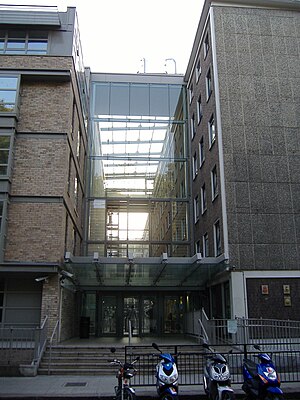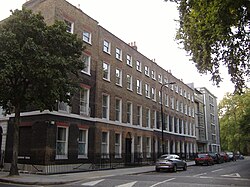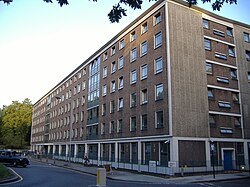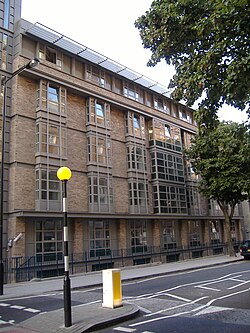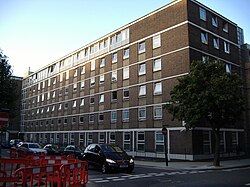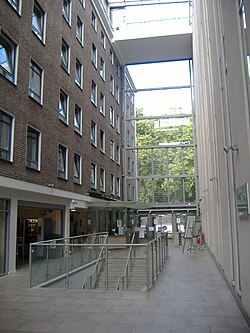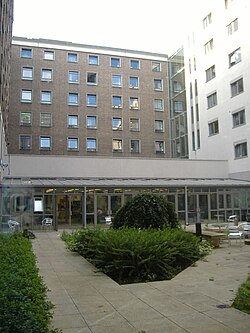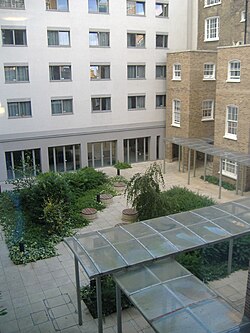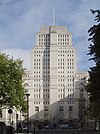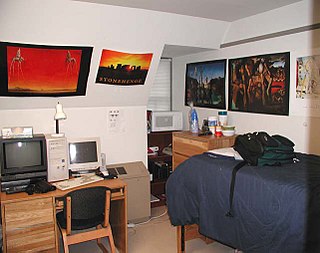
A dormitory, also known as a hall of residence or a residence hall, is a building primarily providing sleeping and residential quarters for large numbers of people such as boarding school, high school, college or university students. In some countries, it can also refer to a room containing several beds accommodating people.

This is a list of halls of residence on the various campuses of the University of Nottingham in Nottingham, England.

The University of Exeter offers approximately 5,900 purposebuilt student bed spaces for its students. The majority of its residences are located on campus, although 30% of self-catered accommodations are located off-campus.

Connaught Hall is a fully catered hall of residence owned by the University of London and situated on Tavistock Square, Bloomsbury, London, UK. It is an intercollegiate hall, and as such provides accommodation for full-time students at constituent colleges and institutions of the University of London, including King's College, University College London (UCL), Queen Mary, the London School of Economics (LSE) and the School of Oriental and African Studies and others.
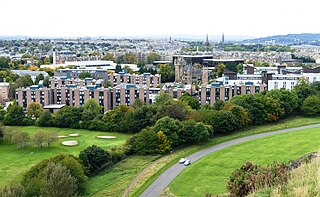
Pollock Halls of Residence is the largest halls of residence for the University of Edinburgh, located in St Leonard's, Edinburgh, Scotland, near the foot of Arthur's Seat. The complex of buildings houses more than 2,000 undergraduate students during term time, and is available to the public as bed and breakfast-style accommodation outside of the teaching term. While some of the buildings date from the 19th century, the majority of Pollock Halls dates from the 1960s and early 2000s. Pollock Halls are located on the edge of Holyrood Park, 1+1⁄4 miles (2.0 km) southeast of the centre of Edinburgh, and 3⁄4 mile (1.2 km) from the university's central area around George Square.

Wessex Lane Halls is a halls of residence complex owned by the University of Southampton. It is situated in the Swaythling district of Southampton, approximately one mile north-east of the university campus in Highfield.

Nutford House is a university hall of residence in London, located on the corner of Nutford Place and Brown Street, near Marble Arch in the City of Westminster.
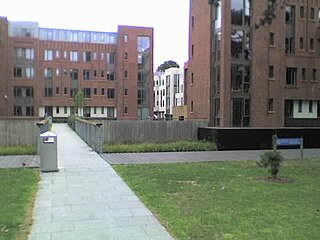
Trinity Hall is the main extramural hall of residence for students of Trinity College in Dublin, Ireland. It is located on Dartry Road in Dartry within Rathmines, about four kilometres south of the college's main campus. Trinity's Botanic Gardens share the site.
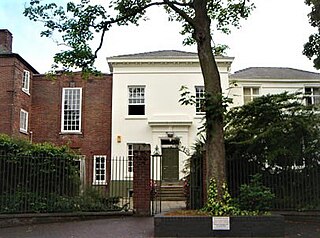
St Anselm Hall, known colloquially as Slems, is a traditional University of Manchester hall of residence situated in Victoria Park.

Manor Hall is a student hall of residence at the University of Bristol. Situated in the Georgian/Victorian suburb of Clifton, Bristol, it provides self-catering accommodation for around 340 residents, both in the main hall itself and also in a number of nearby surrounding annexes. The majority of residents are first year undergraduate students, but a number of 'returners' choose to stay on to contribute to the hall's life and community in subsequent years of study.

A common room is a group into which students are organised in some universities, particularly in the United Kingdom, normally in a subdivision of the university such as a college or hall of residence, in addition to an institution-wide students' union. They represent their members within the hall or college, operate certain services within these institutions such as laundry or recreation, and provide opportunities for socialising. There are variations based on institutional tradition and needs, but classically the following common rooms will exist:

Hughes Parry Hall was one of eight intercollegiate halls of the University of London. The Hall was part of the Garden Halls grouping administered by the bursarial team also responsible for Canterbury Hall and Commonwealth Hall.

This is a list of halls of residence both on and off campus at the University of Leeds in Leeds, England.
Halls of residence at the University of Bristol are generally located within three distinct areas of Bristol, the City Centre, Clifton and Stoke Bishop.

St Salvator's Hall is a student hall of residence at the University of St Andrews. It lies close to the quadrangle of the United College, St Andrews and St Salvator's Chapel, a foundation which was endowed by King James II of Scotland. The Hall is in an area between North Street and The Scores. Architecturally, it has been described as a "rambling Gothic dormitory".
Commonwealth Hall was one of eight intercollegiate halls of the University of London, opened in the 1960s and was situated in Cartwright Gardens, London, between Bloomsbury and Euston Road. Latterly, it became part of the Garden Halls, with Canterbury, and Hughes Parry Hall.
This is a list of the halls of residence at University College London in London, England.

Bruce Hall is a residential college of the Australian National University (ANU), in Canberra, Australia. Opened in 1961, the original Bruce Hall was a campus landmark and housed both the first undergraduate hall of residence at the university and the first in Australia to admit both men and women. The college has produced notable alumni across a range of fields.
College Hall is a fully catered hall of residence of the University of London. It is situated on Malet Street in the Bloomsbury district of central London. It is an intercollegiate hall, and as such provides accommodation for full-time students at constituent colleges and institutions of the University, including King's College, University College, Queen Mary, the London School of Economics and the School of Oriental and African Studies amongst others.

Victoria House is a privately owned residential college of Victoria University of Wellington located in the city of Wellington in New Zealand. It is home to 182 undergraduates, typically first year students. Opened in 1907 as the Women Student's Hostel Society, Victoria House is the oldest hall of residence at Victoria University of Wellington, and the second hall of residence for women students in New Zealand.
